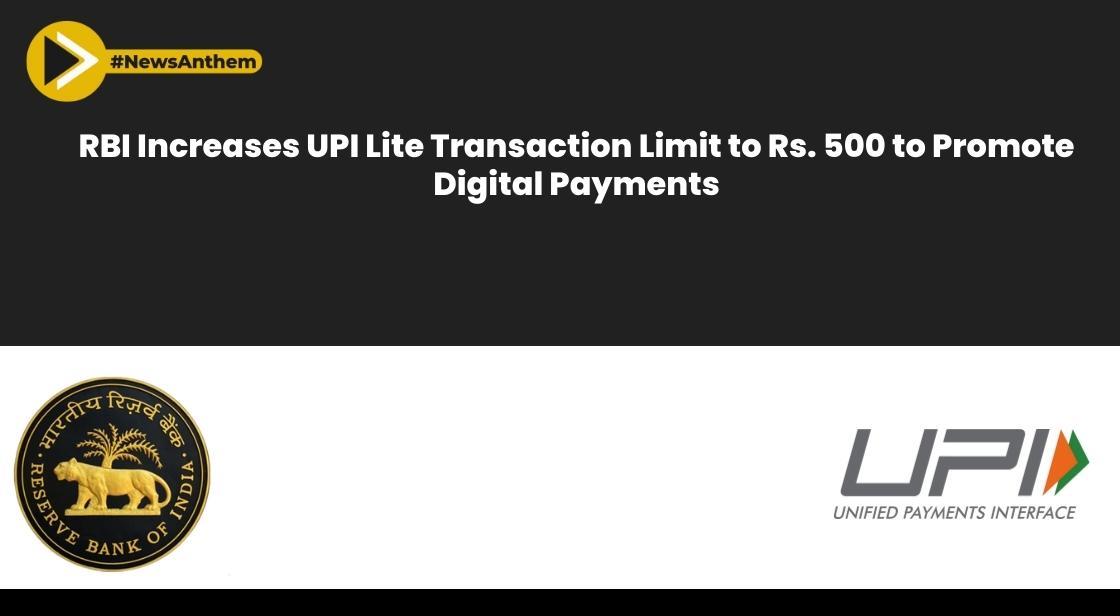RBI Enhances UPI Lite Transaction Limit to Promote Digital Transactions: Key Developments and Impact

News Synopsis
The Reserve Bank of India (RBI) has announced that it will increase the per-transaction payment limit for Unified Payments Interface (UPI) Lite in offline mode to Rs. 500 (US$ 6.04) from Rs. 200 (US$ 2.41). This move is aimed at promoting digital payments and making them more accessible to people across the country.
UPI Lite is a simplified version of UPI that is designed for feature phones. It does not require users to enter their UPI PIN, making it faster and easier to use. The increased transaction limit will make UPI Lite more suitable for a wider range of use cases, such as making payments at small shops and businesses.
In addition to increasing the transaction limit for UPI Lite, the RBI has also announced two other measures to promote digital payments. First, it will enable "Conversational Payments" on UPI, which will allow users to make payments by simply talking to an AI-powered system. Second, it will introduce offline payments on UPI using Near Field Communication (NFC) technology. This will allow users to make payments without internet connectivity, which is especially useful in rural areas.
These measures are part of the RBI's ongoing efforts to promote digital payments and make them more accessible to people across India. The RBI believes that digital payments can help to boost economic growth and financial inclusion.
Expanding UPI Lite Limits: A Catalyst for Digital Adoption
The RBI's decision to elevate the per-transaction limit for UPI Lite transactions in offline mode to Rs. 500 (US$ 6.04) from Rs. 200 (US$ 2.41) carries the potential to significantly boost the adoption of digital payments. UPI Lite transactions cater to small-value payments and offer seamless, contactless, and expedient payment solutions for everyday transactions, including transit payments.
Streamlining Small-Value Transactions: Benefits and Rationale
By permitting higher per-transaction limits for UPI Lite in offline mode, the Reserve Bank aims to streamline and simplify the process of small-value transactions, eliminating the need for two-factor authentication. This enhances the user experience for routine transactions, encouraging individuals to opt for digital payments even for modest purchases, thereby contributing to the larger goal of reducing cash usage.
Ensuring Security and Compliance: Setting Overall Limits
While the per-transaction limit has been raised, the Reserve Bank has maintained an overall limit of Rs. 2,000 (US$ 24.15) per payment instrument. This strategic move is aimed at ensuring security and compliance while still promoting the convenience of digital transactions. Additional guidelines pertaining to this overall limit are anticipated to be released shortly, underscoring the Reserve Bank's commitment to maintaining a balance between security and ease of use.
Innovative Advancements: AI-Powered "Conversational Payments" and Offline UPI
To further enrich the digital payments ecosystem, RBI is exploring new avenues for convenience and accessibility. "Conversational Payments" on UPI are on the horizon, enabling users to interact with AI-powered systems for seamless payments. Additionally, the introduction of offline payments on UPI through Near Field Communication (NFC) technology, branded as "UPI-Lite," is poised to provide users with greater flexibility in making digital payments. This advancement will cater to both smartphones and feature phones, fostering digital inclusion across different user segments.
Language Inclusivity and Future Prospects
RBI's visionary approach extends to language inclusivity as well. The new "Conversational Payments" feature will initially be available in Hindi and English, with plans to extend its availability to other Indian languages. This step aligns with the broader vision of making digital payments accessible and user-friendly for all segments of the population.
Some relevant and latest facts about the RBI's decision to increase the per-transaction payment limit for UPI Lite:
-
The decision was announced on August 10, 2023, by RBI Governor Shaktikanta Das.
-
The increased transaction limit will take effect from September 1, 2023.
-
The move is aimed at promoting digital payments and making them more accessible to people across the country.
-
UPI Lite is a simplified version of UPI that is designed for feature phones. It does not require users to enter their UPI PIN, making it faster and easier to use.
-
The increased transaction limit will make UPI Lite more suitable for a wider range of use cases, such as making payments at small shops and businesses.
-
The RBI has also announced two other measures to promote digital payments:
-
It will enable "Conversational Payments" on UPI, which will allow users to make payments by simply talking to an AI-powered system.
-
It will introduce offline payments on UPI using Near Field Communication (NFC) technology. This will allow users to make payments without internet connectivity, which is especially useful in rural areas.
-
The RBI's decision to increase the per-transaction payment limit for UPI Lite is a positive step towards promoting digital payments in India. It will make UPI Lite more accessible to a wider range of users and help to drive adoption of digital payments across the country.
Conclusion: Ushering in a New Era of Digital Payments
RBI's decision to enhance the UPI Lite transaction limit, introduce innovative features, and explore offline UPI with NFC technology signifies a significant stride towards a more digitally empowered India.
By amalgamating technology-driven solutions with pragmatic security measures, RBI is fostering an environment conducive to digital adoption while prioritizing user convenience and financial security.
As these initiatives unfold, they are poised to reshape the digital payments landscape and accelerate India's journey towards becoming a cash-lite economy.
You May Like









